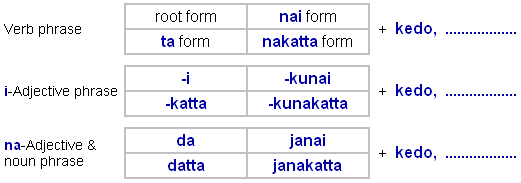I introduce some expressions here corresponding to the English, "but."

kedo
It corresponds to the English, "but." This pattern comes after
desu, the
masu form and the plain form. When it comes after
desu and
masu, it sounds more polite.
Kedo is put between a sentence and a sentence, or a phrase and a phrase.
That is, it works to change the sentence meaning.
| 1. | Yamada-san ni denwa shita kedo, uchi ni imasendeshita. |
| I called up Yamada, but he wasn't there. |
| 2. | Kono resutoran wa oishii kedo, takai desu. |
| This restaurant is good (lit. delicious) but expensive. |
| 3. | Ryokoo ni iki-tai kedo, jikan ga arimasen. |
| I want to go on a trip, but I don't have time. |
| 4. | Paatii ni iki-takatta kedo, yooji ga atta kara, ikimasendeshita. |
| I wanted to go to the party, but I didn't go due to my work. |
See the example 3 and 4. -Tai is the pattern used to show one's desire,
and corresponds to "want." It behaves like an i-adjective.
See Part 3; Chapter 13.
Both kedo and kara
described in the previous chapter are often used with -tai.

dakedo
While kedo is used between the sentences or the phrases,
dakedo has to be at the head of the sentence.
In other words, you can begin the sentence with it.
| 5. | Yooko | : | Nikkoo ni itta soo desu ne. Kirei datta deshoo. |
| Keiko | : | Un, kirei datta. Dakedo ame ga futta kara, samukatta. |
| Yooko | : | You went to Nikko, didn't you? It must be beautiful. |
| Keiko | : | Yes, it was. But it was cold due to the rain. |
| 6. | Katoo | : | Yamada-san ni denwa shimashita ka? |
| Satoo | : | Ee, shimashita. Dakedo imasendeshita. |
| Katoo | : | Did you call up Yamada? |
| Satoo | : | Yes, I did. But he wasn't there. |
The example 5 and 6 can also make use of kedo like
kirei datta kedo,
ame ga..., / debwa shita kedo, imasendeshita.
As dakedo enables the speaker to end the former sentence,
so the latter sentence can be emphasized.

demo
It is used at the beginning of the sentence in the same way as dakedo.
Mostly it is interchangeable with dakedo.
Demo sounds more polite than dakedo.
| Yamada-san ni denwa shimashita. Demo uchi ni imasendeshita. |
| I called Yamada. But he was not at home. |
| Katoo | : | Hon-ya ni ikimashita ka? |
| Satoo | : | Ee, ikimashita. Demo yasumi deshita. |
| Katoo | : | Did you go to the book store? |
| Satoo | : | Yes, I did. But it was closed. |
| Yooko | : | Keiko-san no apaato wa eki ni chikai kara, benri desu ne. |
| Keiko | : | Ee. Demo yachin ga takai desu. |
| Yooko | : | Your apartment is convenient as it's near the station, Keiko. |
| Keiko | : | Yes. But the rent is high. |

ga
When the particle ga follows the sentence or the phrase,
it means "but." It is interchangeable with kedo,
but ga sounds more polite than kedo.
It comes after desu or -masu in daily conversation.
Following the plain form, it sounds very decisive or abrupt.
| Yamada-san ni denwa shimashita ga, imasendeshita. |
| I called Yamada, but he wasn't there. |
| Furansu-go o benkyoo shimashita ga, joozu janai desu. |
| I've studied French, but I'm not good at it. |

shikashi
Like demo, this is used at the beginning of the sentence.
It sounds very strong. Therefore, it is mostly used in cases of serious discussion or in literary Japanese.
Nichi-bei shunoo wa keizai-mondai ni tsuite iken o kookan shita.
Shikashi ookii seika wa nakatta.
|
The US and Japan leaders exchanged opinions on the economic issues.
But no great result was produced. |
